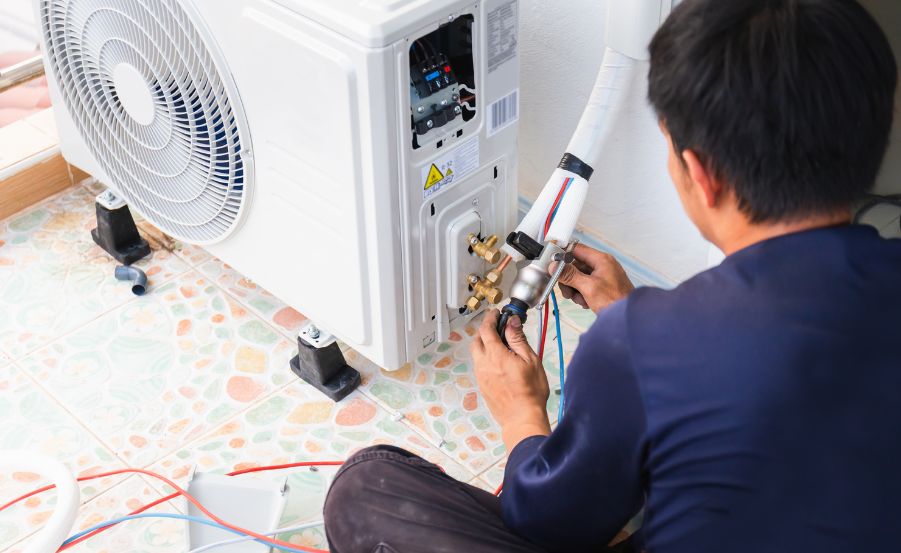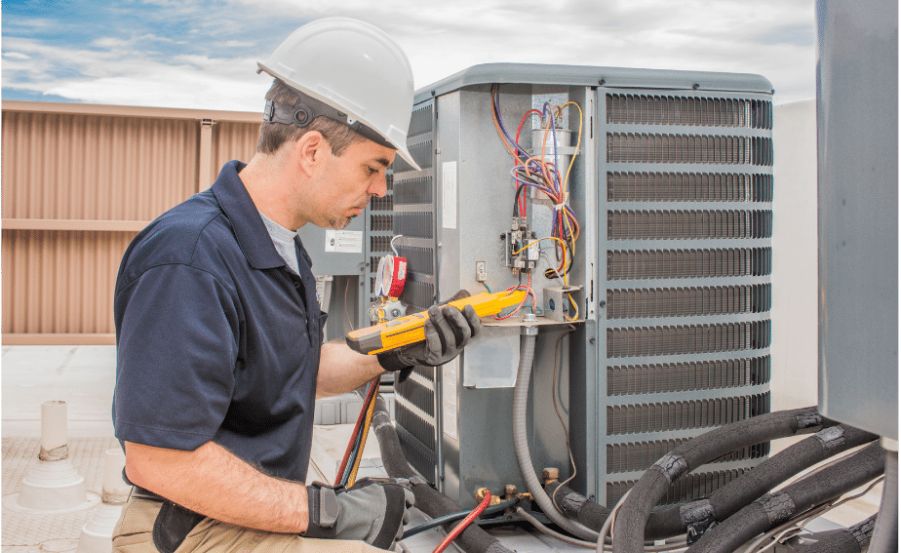
What is Freon and How Does it Work?
When it comes to keeping your home cool and comfortable in Florida’s humid climate, understanding how your air conditioning system works is essential. One of the most important components of that system is the refrigerant, commonly known by the brand name Freon. But what is Freon, how does it work, and what role does it play in your AC system?
This comprehensive guide explains everything you need to know, from how AC refrigerant works to why choosing the right system matters. We’ll also answer common questions such as “Is Freon toxic?”, “Is Freon flammable?” and whether Freon and refrigerant are the same thing. Plus, learn how Natal Air Conditioning can help with refrigerant replacement, AC repairs, and new AC installations throughout South Florida.
What Is Freon?
Freon is a trademarked name for a group of chemicals used as refrigerants in air conditioning, refrigeration, and other cooling applications. It falls under the category of chlorofluorocarbons (CFCs) and hydrochlorofluorocarbons (HCFCs), with R-22 being the most recognized variant used in older AC units.
Freon is responsible for absorbing and transferring heat, allowing your system to cool indoor air. Today, Freon is being phased out due to its harmful environmental effects, and more eco-friendly refrigerants such as R-410A and R-32 are taking its place. However, the term “Freon” is still commonly used to refer to any type of refrigerant, especially among homeowners.
What is Refrigerant and How Does it Work?
If you’re wondering what refrigerant is, it refers to the working fluid in your HVAC system. Whether it’s Freon or a modern replacement, all refrigerants operate on the same principle: heat exchange.
Here’s a simplified overview of the process:
- Evaporation: The refrigerant absorbs heat from your indoor air and turns into a gas.
- Compression: The gas is pressurized, raising its temperature and preparing it for heat release.
- Condensation: The hot gas is transferred to the outdoor unit, where it releases heat and turns back into a liquid.
- Expansion: The liquid passes through an expansion valve, cooling it before it returns to the indoor coil to repeat the cycle.
This continuous process makes your AC effective at maintaining comfortable temperatures inside your home. Whether you refer to it as Freon AC or not, refrigerant is the backbone of your cooling system.
Is Freon Toxic?
Yes, under certain conditions. While Freon is contained safely within your AC system during normal operation, exposure to leaking Freon can be harmful. Symptoms of exposure include:
- Dizziness
- Nausea
- Headaches
- Skin or eye irritation
- Frostbite (from direct contact)
If you suspect a refrigerant leak, it’s critical to call a professional immediately. Natal Air Conditioning provides AC repair and refrigerant leak detection across Broward and Palm Beach counties. Our EPA-certified technicians ensure safe handling of all refrigerants, including old AC Freon and modern replacements.
Is Freon Flammable?
Traditional Freon types like R-22 and R-134a are non-flammable. However, newer refrigerants like R-32 are mildly flammable but are still considered safe when used in properly designed and installed systems.
At Natal Air Conditioning, our experts will ensure your refrigerant type is safe, up to code, and compatible with your AC system. We prioritize safety and use only the most current refrigerant types during repairs and installations.
Is Refrigerant the Same as Freon?
Not exactly. Freon is a type of refrigerant, but not all refrigerants are Freon. Freon is a brand name, much like how people say “Kleenex” for facial tissues. So while Freon is a refrigerant, not all refrigerants are Freon.
Modern refrigerants like R-410A (Puron) and R-32 are used in new systems and offer better energy efficiency and less environmental harm. If you’re unsure what type your system uses, our technicians at Natal Air Conditioning can check and recommend appropriate upgrades.
How Freon and Refrigerant Type Affect AC Performance and Longevity?
The type of AC refrigerant used in your system plays a significant role in its overall performance, efficiency, and lifespan. Older systems that still rely on Freon (R-22) are not only harder to service due to phase-outs but also tend to be less energy-efficient compared to systems using modern refrigerants like R-410A. These newer options operate at higher pressures and provide better heat transfer, which translates to faster, more consistent cooling and reduced strain on system components.
Using the right refrigerant also ensures your compressor and evaporator coil remain in optimal condition for longer. In contrast, mismatched or degraded refrigerant can cause short cycling, uneven cooling, and even system failure. That’s why at Natal Air Conditioning USA, we take refrigerant compatibility seriously—especially when replacing older systems or servicing units during maintenance checks.
Freon Phase-Out: What Florida Homeowners Need to Know
Due to its ozone-depleting properties, the U.S. Environmental Protection Agency (EPA) officially banned the production and import of R-22 Freon as of January 1, 2020. Homeowners with older systems still using R-22 are strongly encouraged to consider new AC installation with modern, eco-friendly refrigerants.
We provide affordable, energy-efficient options for AC replacement in Deerfield Beach, Boca Raton, Pembroke Pines, Coral Springs, and throughout South Florida.
Signs You Need AC Freon Service
How do you know if your system needs AC Freon service? Look for the following symptoms:
- Warm air is blowing from vents
- Ice on refrigerant lines or the AC evaporator coil
- Unusual hissing or bubbling noises (indicating a leak)
- Increased energy bills without explanation
- Longer-than-normal cooling cycles
If you notice any of these issues, it could point to low refrigerant levels or a system malfunction. Natal Air Conditioning can quickly diagnose and resolve the problem, whether you need a recharge or a full system upgrade.
AC Refrigerant and Efficiency: Why It Matters
Using the right amount and type of AC refrigerant is essential for system performance. If your refrigerant is too low or leaking, your system will work harder and less efficiently, leading to:
- Higher utility bills
- Reduced comfort
- Shortened system lifespan
- Frequent repairs
Our team performs detailed diagnostics to ensure refrigerant levels are balanced, sealed, and functioning efficiently year-round. Regular maintenance helps catch minor issues before they escalate.
Benefits of Upgrading to a Modern AC System
If your system still uses Freon AC, now is the time to upgrade. Modern AC units using R-410A and R-32 offer several advantages:
- Greater energy efficiency
- Lower operating costs
- Improved indoor air quality
- Quiet operation
- Smart thermostat compatibility
- Better performance in humid climates
At Natal Air Conditioning, we make new AC installations simple. From helping you choose the right system to handling permits and full setup, our experienced techs deliver a stress-free process with transparent pricing.
AC Freon Services Offered by Natal Air Conditioning
We specialize in complete AC refrigerant services, including:
- Refrigerant leak detection and repair
- Refrigerant recharge and replacement
- Retrofits for systems using obsolete Freon
- Full AC system upgrades and installation
- Preventative maintenance with refrigerant checks
Our technicians are certified, experienced, and committed to delivering lasting comfort to your South Florida home or business.
How to Tell Which Refrigerant Your System Uses?
You can check your AC refrigerant type by locating the label on the outdoor condenser unit. Look for terms like:
- R-22: Freon (older systems)
- R-410A: Puron (newer systems)
- R-32: Modern, efficient systems
These labels are typically printed on a metal nameplate located near the service valves or electrical panel of your unit. Be sure to turn off the power to the system before attempting to inspect it. If the label is faded or missing, don’t guess—using the wrong refrigerant can cause severe damage to your AC unit. Some systems may also have color-coded caps or markings to indicate their refrigerant type.
Still unsure? Give Natal Air Conditioning a call. We’ll inspect your system and recommend the best solutions for refrigerant compatibility, safety, and performance. Whether you’re considering an upgrade, recharge, or maintenance visit, our certified technicians are ready to help across South Florida.
Why Choose Natal Air Conditioning?
We’re more than just another HVAC provider. We’re your local partner for reliable, eco-conscious cooling solutions. Our services include:
- Emergency AC repair and refrigerant recharging
- Seasonal tune-ups and maintenance
- AC replacement and installation
- Indoor air quality services
- Energy-efficient upgrades
With years of experience serving South Florida, our team understands the unique cooling challenges that come with our hot and humid climate. Whether you’re dealing with outdated equipment or need help selecting the right AC refrigerant, we’ll guide you every step of the way. Our certified technicians are trained to work on all system types and refrigerants, from traditional Freon-based units to modern, high-efficiency alternatives.
We proudly serve clients throughout Boca Raton, Deerfield Beach, Pembroke Pines, Coral Springs, Hollywood, and the surrounding areas. At Natal Air Conditioning, we prioritize your comfort, safety, and satisfaction—no matter the season.
Final Thoughts on Freon and Modern AC Cooling
Understanding what Freon is and its role in your system is essential for making smart decisions about your home’s cooling. Whether you need AC Freon service, a refrigerant recharge, or are exploring new AC installation, Natal Air Conditioning USA is here to help.
Stay cool and comfortable with expert solutions from our licensed, highly-rated team. Contact us at (954) 788-0099 to schedule a consultation today.

















